Seasonal Evaluation of Freshness Profile of Commercially Important Fish Species
Abstract
:1. Introduction
2. Materials and Methods
2.1. Animals
2.2. Fish Storage
2.3. Sensorial Analysis (Organoleptic Parameters)
2.4. Physical Analysis
2.5. Microbiological Analysis
2.6. Data Analyses
3. Results
3.1. Farmed Species
3.1.1. Gilthead Seabream
3.1.2. European Seabass
3.2. Wild Species
3.2.1. Atlantic Horse Mackerel
3.2.2. Atlantic Chub Mackerel
3.2.3. Sardine
3.2.4. PCO Ordinations
4. Discussion
5. Conclusions
Supplementary Materials
Author Contributions
Funding
Acknowledgments
Conflicts of Interest
References
- Pal, M.; Ketema, A.; Anberber, M.; Mulu, S.; Dutta, Y. Microbial quality of fish and fish products. Beverage Food World 2016, 43, 2. [Google Scholar]
- Rodríguez-Jérez, J.J.; Hernández-Herrero, M.M.; Roig-Sagués, A.X. New methods to determine fish freshness in research and industry. In Global Quality Assessment in Mediterranean Aquaculture; CIHEAM: Zaragoza, Spain, 2000; pp. 63–69. [Google Scholar]
- Freitas, J.; Vaz-Pires, P.; Câmara, J.S. From aquaculture production to consumption: Freshness, safety, traceability and authentication, the four pillars of quality. Aquaculture 2020, 518, 734857. [Google Scholar] [CrossRef]
- Durmus, M.; Polat, A.; Oz, M.; Ozogul, Y.; Uçak, I. The effects of seasonal dynamics on sensory, chemical and microbiological quality parameters of vacuum-packed sardine (Sardinella aurita). J. Food Nutr. Res. 2014, 53, 344–352. [Google Scholar]
- Tidwell, J.H.; Coyle, S.D.; Bright, L.A.; VanArnum, A.; Yasharian, D. Effect of water temperature on growth, survival and biochemical composition of largemouth bass Micropterus salmoides. J. world Aquac. Soc. 2003, 34, 175–183. [Google Scholar] [CrossRef]
- Hassoun, A.; Sahar, A.; Lakhal, L.; Ait-Kaddour, A. Fluorescence spectroscopy as a rapid and non-destructive method for monitoring quality and authenticity of fish and meat products: Impact of different preservation conditions. LWT 2003, 103, 279–292. [Google Scholar] [CrossRef]
- Grassi, S.; Benedetti, S.; Opizzio, M.; Nardo, E.; Buratti, S. Meat and Fish freshness assessment by a portable and simplified electronic nose system (Mastersense). Sensors 2019, 19, 3225. [Google Scholar] [CrossRef] [PubMed] [Green Version]
- Hassoun, A.; Karoui, R. Quality evaluation of fish and other seafood bytraditional and nondestructive instrumental methods: Advantages and limitations. Crit. Rev. Food Sci. Nutr. 2017, 57, 1976–1998. [Google Scholar]
- Hassoun, A.; Shumilina, E.; Donato, F.; Foschi, M.; Simal-Gandara, J.; Biancolillo, A. Emerging techniques for differentiation of fresh and frozen-thawed seafoods: Highlighting the potential of spectroscopic techniques. Molecules 2020, 25, 4472. [Google Scholar] [CrossRef]
- Hassoun, A.; Guðjónsdóttir, M.; Prieto, M.A.; Garcia-Oliveira, P.; Simal-Gandara, J.; Marini, F.; Donato, F.D.; D’Archivio, A.A.; Biancolillo, A. Application of novel techniques for monitoring quality changes in meat and fish products during traditional processing processes: Reconciling novelty and tradition. Processes 2020, 8, 988. [Google Scholar] [CrossRef]
- Agüeria, D.; Sanzano, P.; Vaz-Pires, P.; Rodriguez, E.; Yeannes, M.I. Development of quality index method scheme for common carp stored in ice: Shelf-life assessment by physicochemical, microbiological and sensory quality indices. J. Aquat. Food Prod. Technol. 2016, 25, 708–723. [Google Scholar] [CrossRef]
- Barbosa, A.; Vaz-Pires, P. Quality index method (QIM): Development of a sensorial scheme for common octopus (Octopus vulgaris). Food Control. 2004, 15, 161–168. [Google Scholar] [CrossRef]
- Freitas, J.; Vaz-Pires, P.; Câmara, J.S. Freshness assessment and shelf-life prediction for Seriola dumerili from Aquaculture based on the quality index method. Molecules 2019, 24, 3530. [Google Scholar] [CrossRef] [PubMed] [Green Version]
- Burt, R.; Gibson, D.M.; Jason, A.C.; Sanders, H.R. Comparison of methods of freshness assessment of wet fish. II. Instrumental and chemical assessment of boxed experimental fish. J. Food Technol. 1976, 11, 73–89. [Google Scholar] [CrossRef]
- Oehlenschläger, J. Seafood Quality Assessment. In Seafood Processing: Technology, Quality and Safety; Wiley: Hoboken, NJ, USA, 2014; pp. 359–386. ISBN 9781118346174. [Google Scholar]
- Howgate, P.; Johnston, A.; Whittle, K.J. Multilingual Guide to EC Freshness Grades for Fishery Products; Food Safety Directorate, Ministry of Agriculture, Fisheries and Food: Aberdeen, UK; Torry Research Station: Aberdeen, UK, 1992. [Google Scholar]
- Bernardi, D.C.; Mársico, E.T.; Freitas, M.Q. Quality Index Method (QIM) to assess the freshness and shelf life of fish. Braz. Arch. Biol. Technol. 2013, 56, 587–598. [Google Scholar] [CrossRef]
- Zar, J. Biostatistical Analysis, 4th ed.; Prentice-Hall International: Upper Saddle River, NJ, USA, 1999. [Google Scholar]
- Anderson, M.J.; Gorley, R.N.; Clarke, K.R. PERMANOVA+ for PRIMER: Guide to Software and Statistical Methods; PRIMER-E: Plymouth, UK, 2008; p. 218. [Google Scholar]
- Bremner, H.A.; Sakaguchi, M.A. Critical Look at Whether ‘Freshness’ Can Be Determined. J. Aquat. Food Prod. Technol. 2000, 9, 5–25. [Google Scholar] [CrossRef]
- Calanche, J.; Pedrós, S.; Roncales, P.; Beltrán, J.Á. Design of predictive tools to estimate freshness index in farmed sea bream (Sparus aurata) stored in ice. Foods 2020, 9, 69. [Google Scholar] [CrossRef] [Green Version]
- Silva, F.; Duarte, A.M.; Mendes, S.; Magalhães, E.; Pinto, F.R.; Barroso, S.; Neves, A.; Sequeira, V.; Vieira, A.R.; Gordo, L.; et al. Seasonal Sensory Evaluation of Low Commercial Value or Unexploited Fish Species from the Portuguese Coast. Foods 2020, 9, 1880. [Google Scholar] [CrossRef]
- Tzikas, Z.; Amvrosiadis, I.; Soultos, N.; Georgakis, S. Seasonal variation in the chemical composition and microbiological condition of Mediterranean horse mackerel (Trachurus mediterraneus) muscle from the North Aegean Sea (Greece). Food Control. 2007, 18, 251–257. [Google Scholar] [CrossRef]
- Ferreira, I.; Gomes-Bispo, A.; Matos, J.; Afonso, C.; Cardoso, C.; Castanheira, I.; Motta, C.; Prates, J.A.M.; Bandarra, M. The chemical composition and lipid profile of the chub mackerel (Scomber colias) show a strong seasonal dependence: Contribution to a nutritional evaluation. Biochimie 2020, 178, 181–189. [Google Scholar] [CrossRef]
- Li, C. The Effect of Natural Antioxidant Extracted from Shrimp Shell on Oxidative and Hydrolytic Rancidity of Sable Fish Mince. SDRP J. Food Sci. Technol. 2018, 3, 527–533. [Google Scholar] [CrossRef]
- Pivarnik, L.F.; Kazantzis, D.; Karakoltsidis, P.A.; Constantinides, S.; Jhaveri, S.N.; Rand, A.G. Freshness assessment of six new England fish species using the Torrymeter. J. Food Sci. 1990, 55, 79–82. [Google Scholar] [CrossRef]
- Jay, J.M.; Loessner, M.J.; Golden, D.A. Modern Food Microbiology; Springer: New York, NY, USA, 2005. [Google Scholar]
- Capell, C.; Vaz-Pires, P.; Kirby, R. Use of counts of hydrogen sulphide producing bacteria to estimate remaining shelf life of freshness. In Methods to Determine the Freshness of Fish in Research and Industry, Proceedings of the Final Meeting of the Concerted Action ‘Evaluation of Fish Freshness’ AIR3CT94, 2283; International Institute of Refrigeration: Paris, France, 1997; pp. 175–182. [Google Scholar]
- Kyrana, V.R.; Lougovois, V.P. Sensory, chemical and microbiological assessment of farm-raised European sea bass (Dicentrarchus labrax) stored in melting ice. Int. J. Food Sci. Technol. 2002, 37, 319–328. [Google Scholar] [CrossRef]
- Verbeke, W.; Vanhonacker, F.; Sioen, I.; van Camp, J.; De Henauw, S. Perceived importance of sustainability and ethics related to fish: A consumer behaviour perspective. Ambio 2007, 36, 580–585. [Google Scholar] [CrossRef] [Green Version]
- Engle, C.R.; Quagrainie, K.K.; Dey, M.M. Seafood and Aquaculture Marketing Handbook, 2nd ed.; Wiley Blackwell: Chichester, NJ, USA, 2017. [Google Scholar]

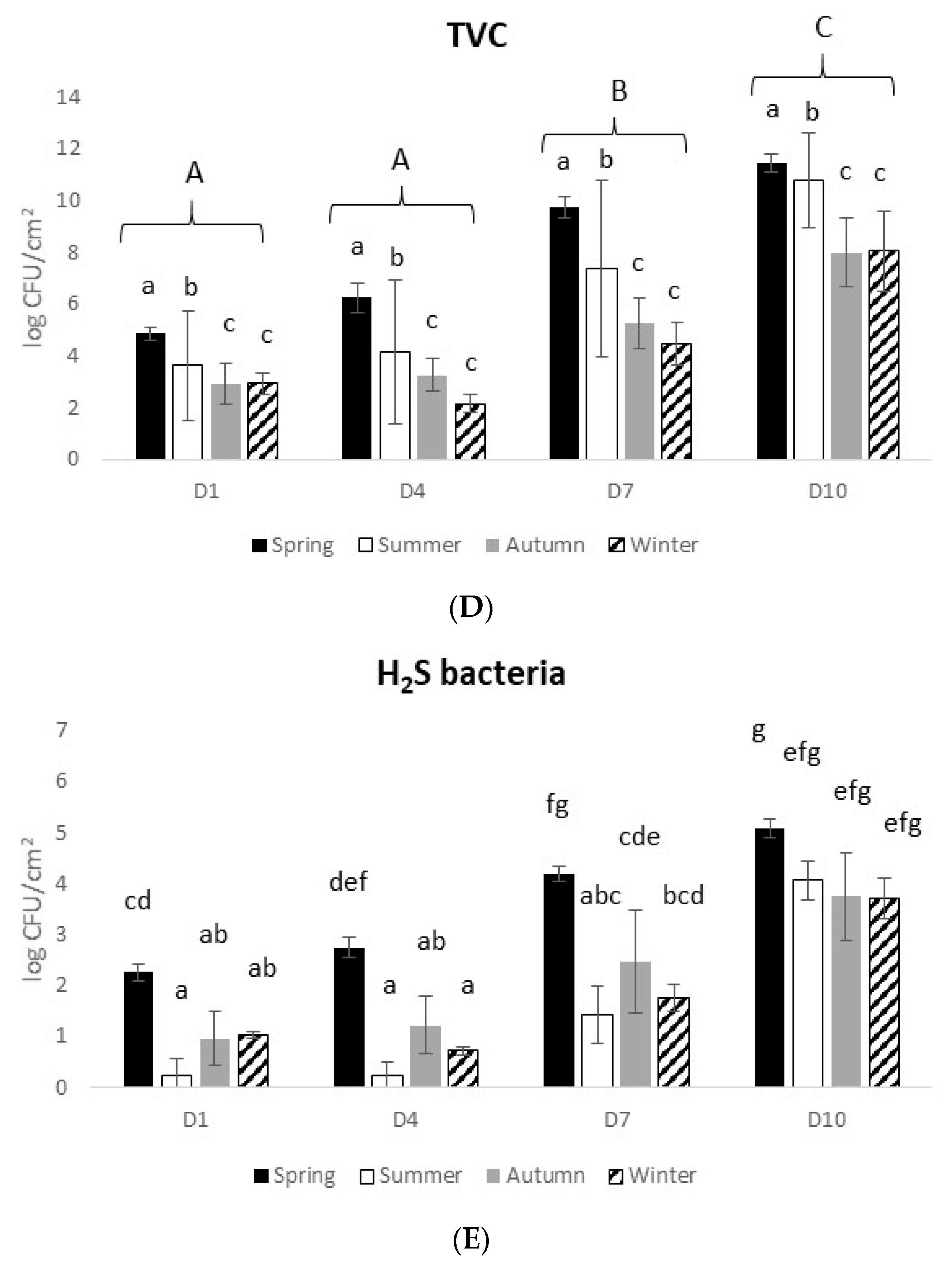

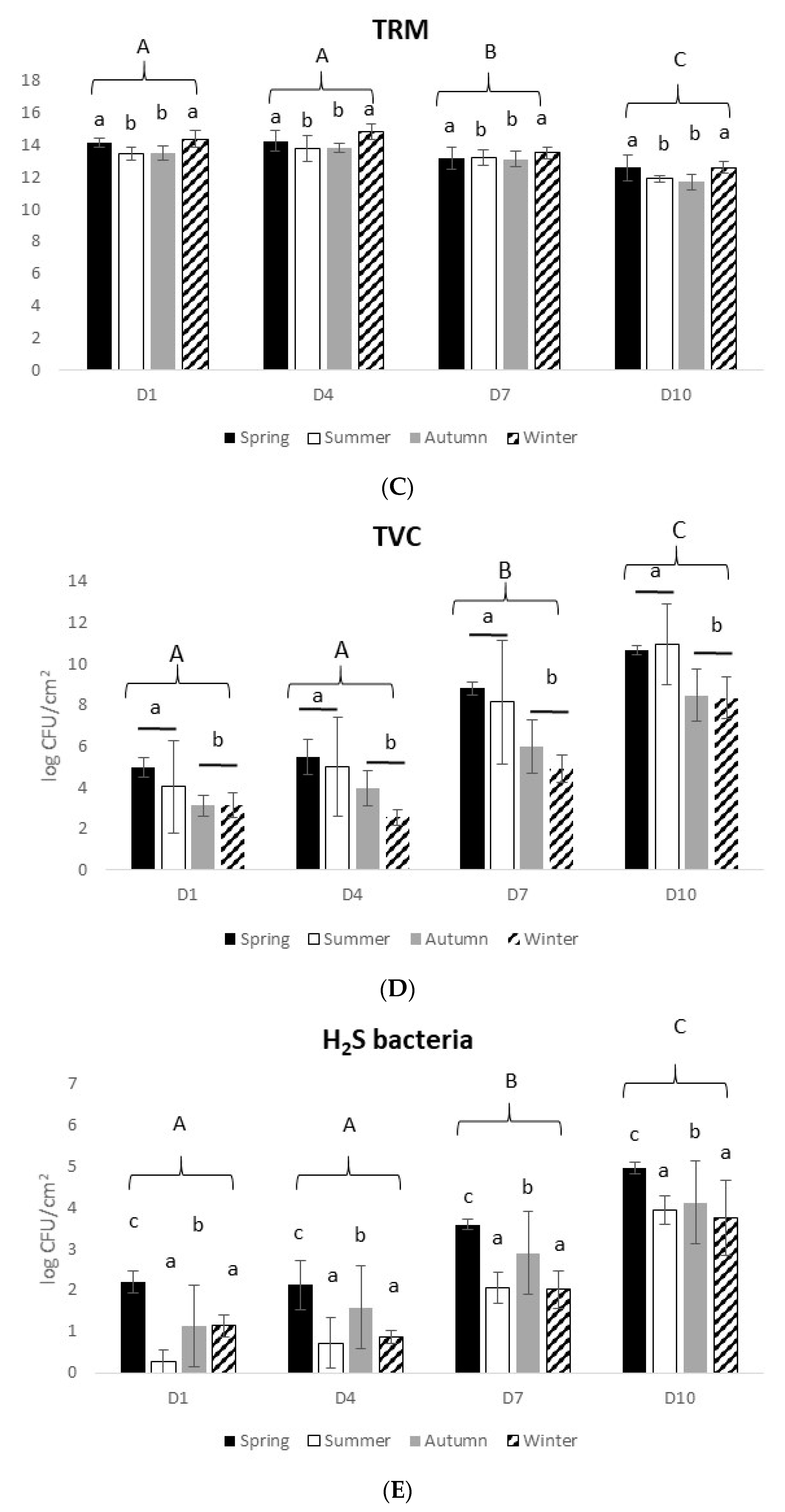
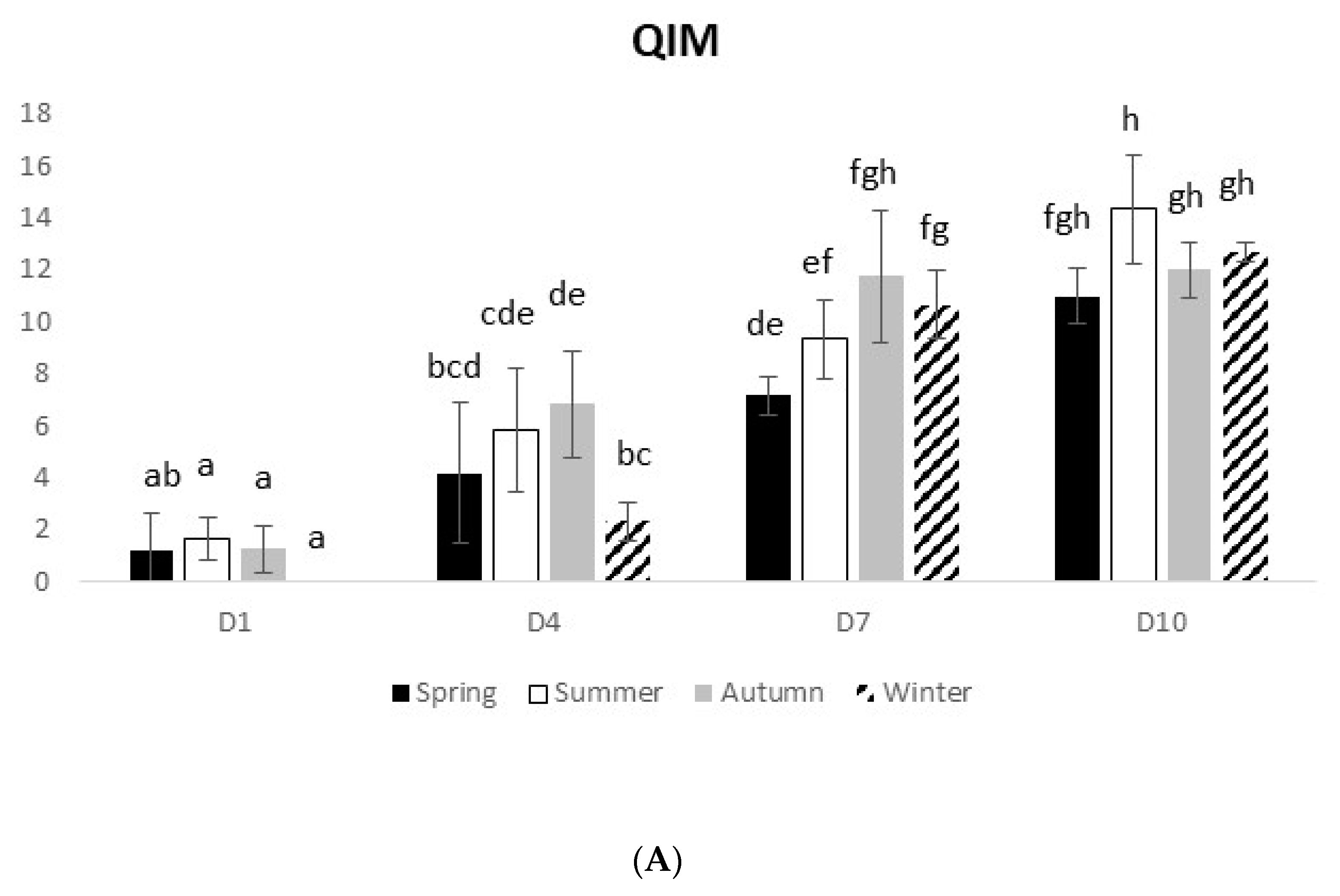
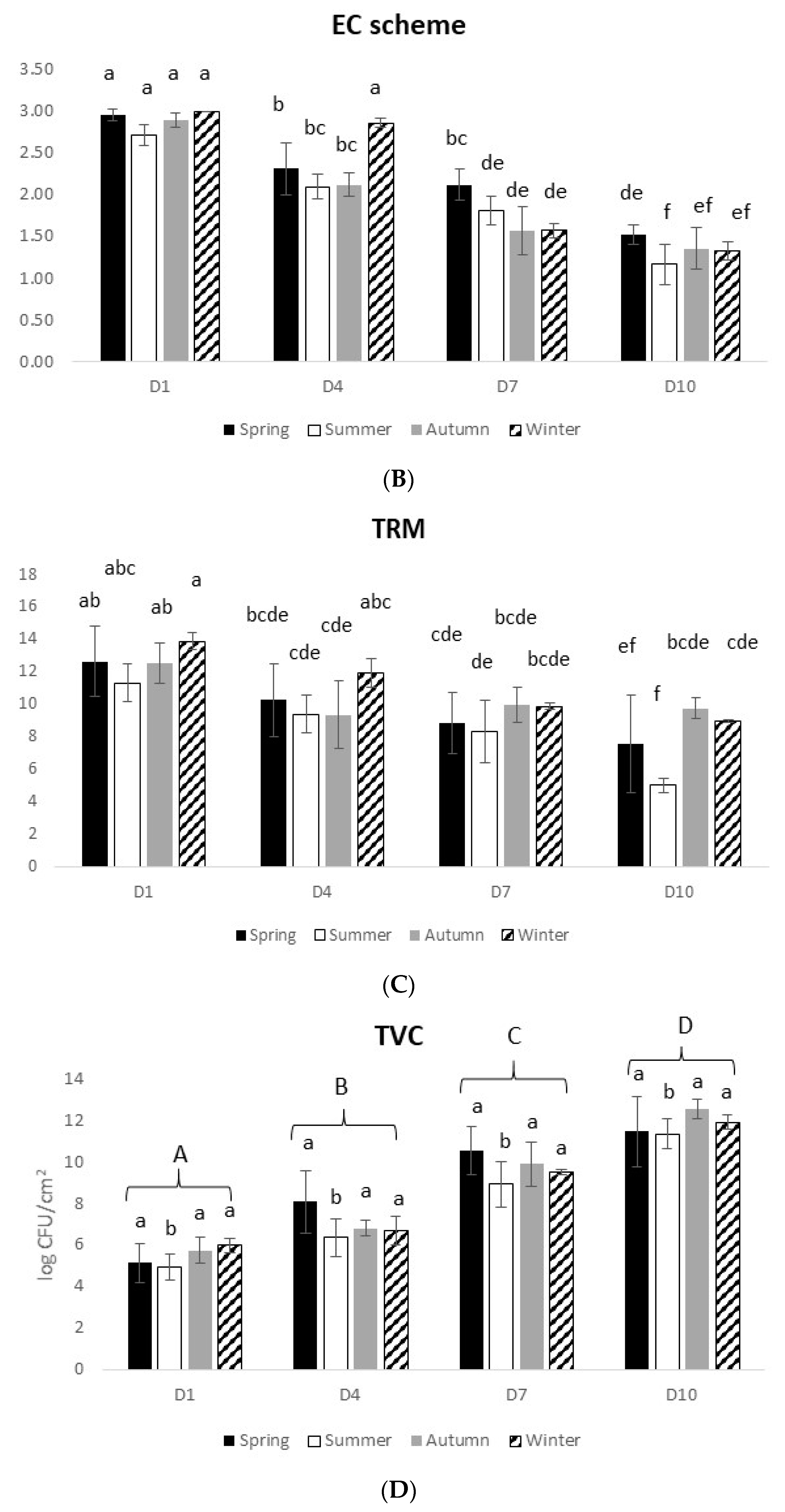

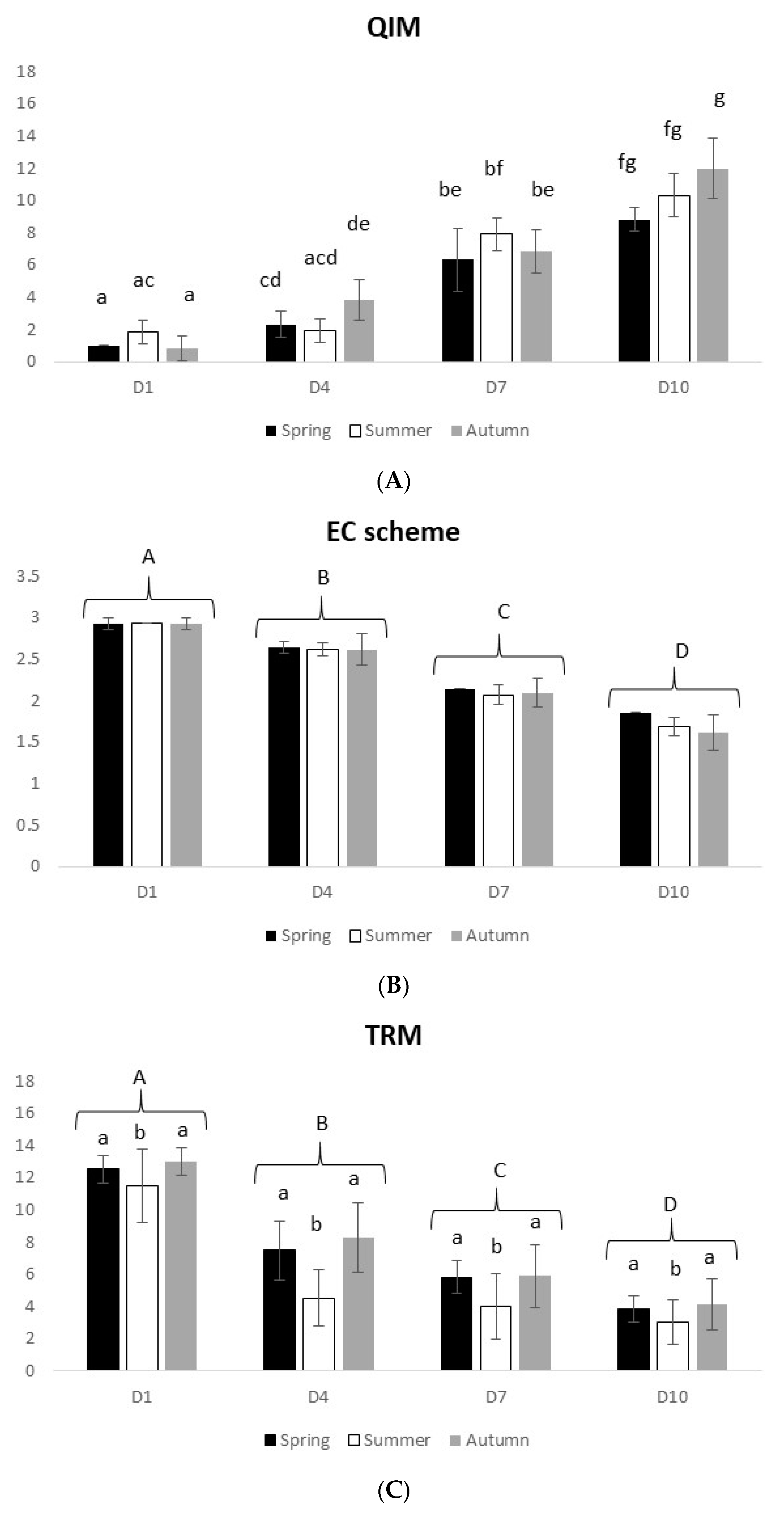
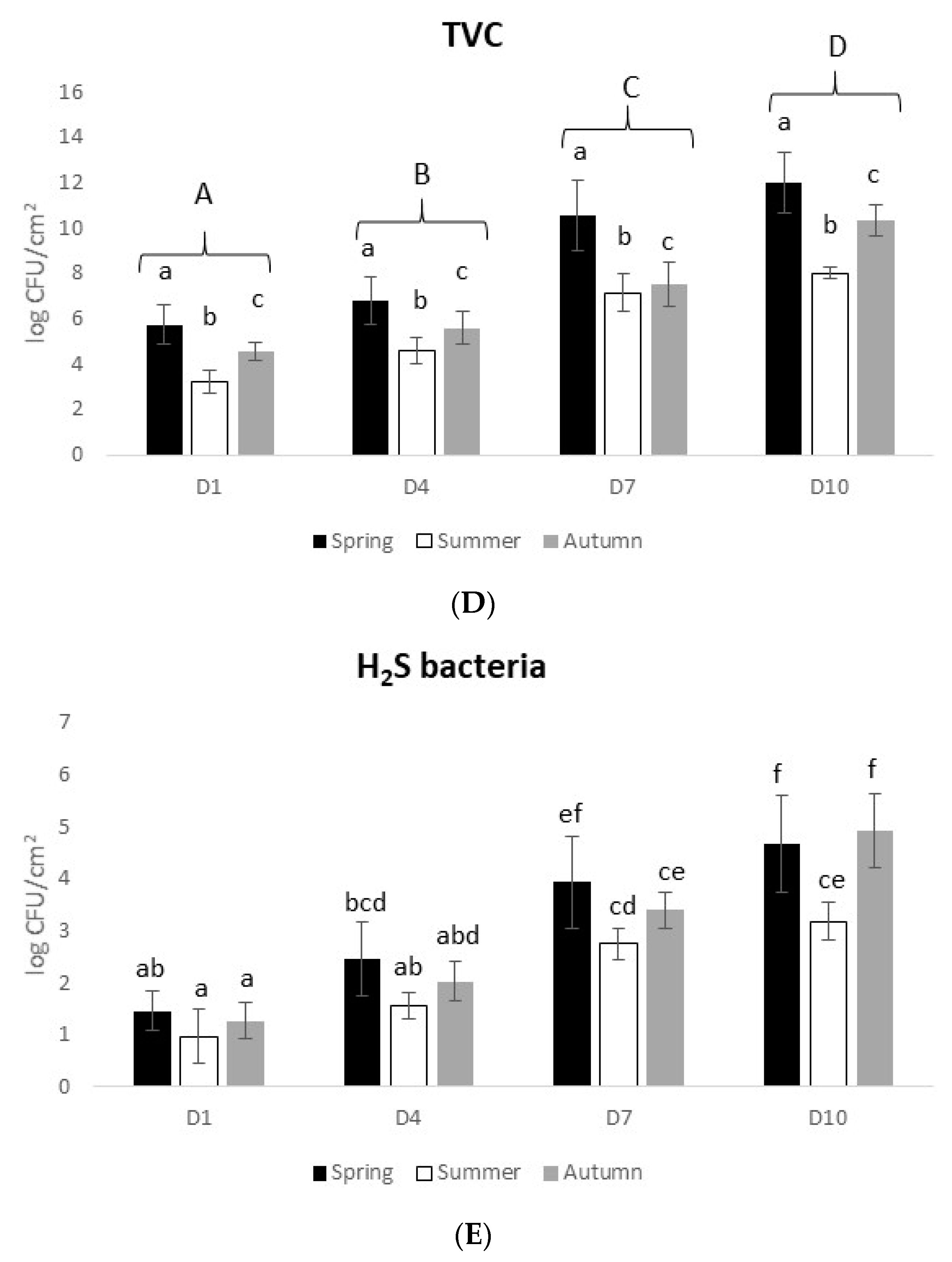
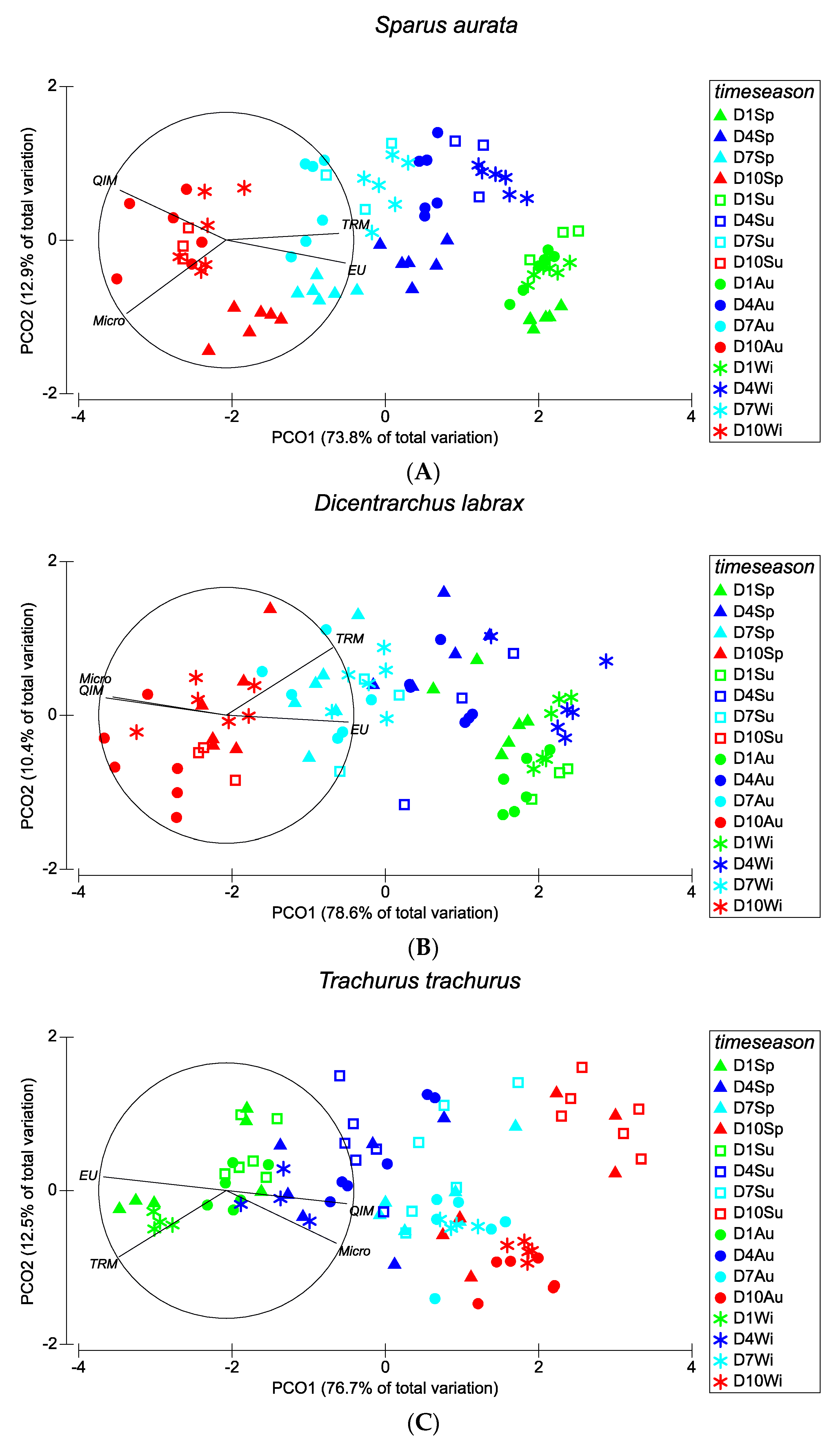


Publisher’s Note: MDPI stays neutral with regard to jurisdictional claims in published maps and institutional affiliations. |
© 2021 by the authors. Licensee MDPI, Basel, Switzerland. This article is an open access article distributed under the terms and conditions of the Creative Commons Attribution (CC BY) license (https://creativecommons.org/licenses/by/4.0/).
Share and Cite
Cardoso, P.G.; Gonçalves, O.; Carvalho, M.F.; Ozório, R.; Vaz-Pires, P. Seasonal Evaluation of Freshness Profile of Commercially Important Fish Species. Foods 2021, 10, 1567. https://doi.org/10.3390/foods10071567
Cardoso PG, Gonçalves O, Carvalho MF, Ozório R, Vaz-Pires P. Seasonal Evaluation of Freshness Profile of Commercially Important Fish Species. Foods. 2021; 10(7):1567. https://doi.org/10.3390/foods10071567
Chicago/Turabian StyleCardoso, Patrícia G., Odete Gonçalves, Maria F. Carvalho, Rodrigo Ozório, and Paulo Vaz-Pires. 2021. "Seasonal Evaluation of Freshness Profile of Commercially Important Fish Species" Foods 10, no. 7: 1567. https://doi.org/10.3390/foods10071567






